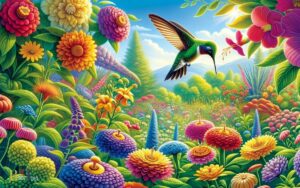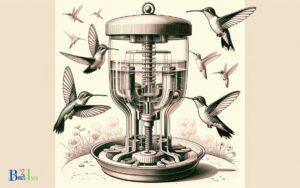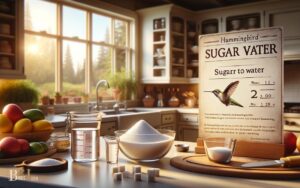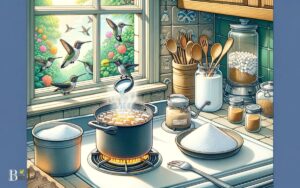Can You Put Plain Water in a Hummingbird Feeder? Discover!
Filling a hummingbird feeder with plain water is not recommended as it does not provide the essential nutrients that hummingbirds need. Instead, a sugar-water mixture should be used to mimic natural nectar.
Hummingbirds require a high-energy diet to sustain their rapid wing flapping, which can reach up to 70 times per second.
Natural nectar from flowers, which is their primary food source, contains sugar that supplies this necessary energy.
When creating a substitute for natural nectar at home, a common recipe is to mix 1 part white granulated sugar with 4 parts water.
Boil the mixture to help dissolve the sugar and eliminate any bacteria or mold spores. Let it cool before filling the feeder.
This solution closely resembles the sugar concentration found in most flowers that hummingbirds feed on.
Do not use:
- Honey, as it can promote harmful fungal growth.
- Artificial sweeteners, as they do not provide calories that hummingbirds need.
- Red dye, as it is unnecessary and could be harmful to birds.
To best support the health and vitality of hummingbirds, always fill your feeders with a homemade sugar-water mixture rather than plain water.
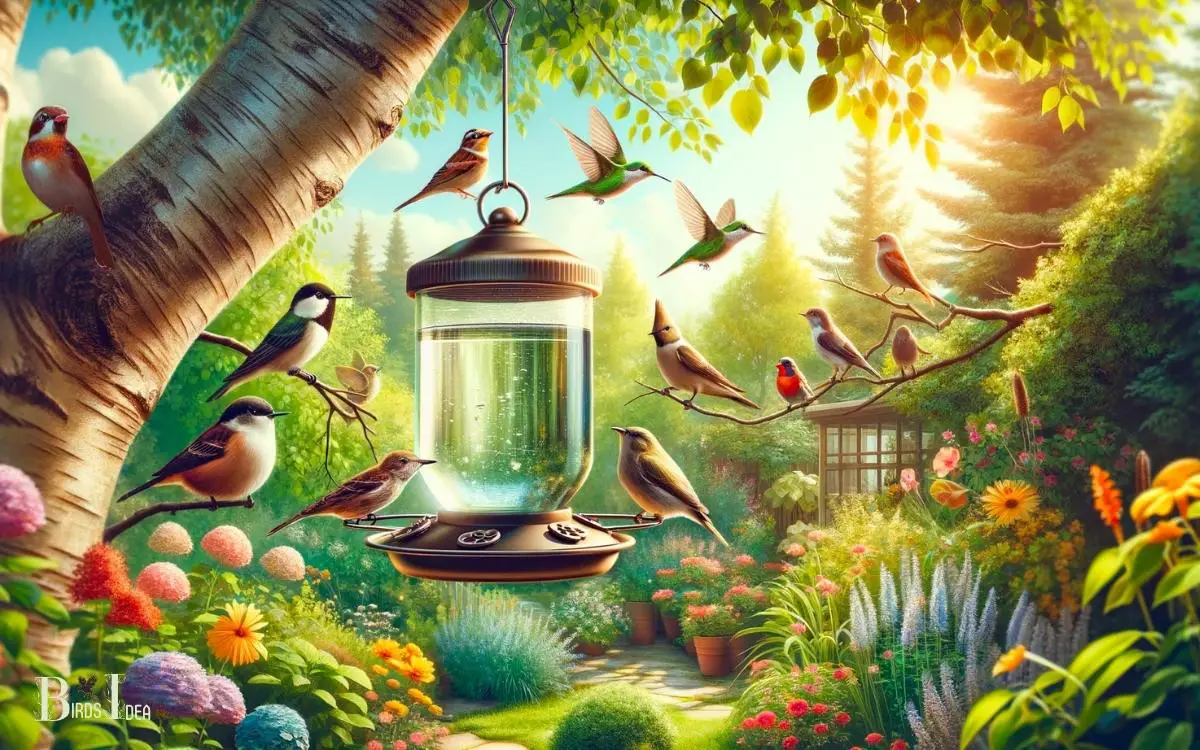
Key Takeaway
Importance of Hummingbird Feeder Liquid
The liquid in a hummingbird feeder serves as a vital source of energy and hydration for the tiny birds.
Hummingbirds have a high metabolism and need to consume large amounts of food to sustain their energy levels.
The nectar or sugar water in the feeder provides them with the necessary calories to fuel their active lifestyle.
The liquid helps to keep the birds hydrated, especially in hot and dry weather conditions. As a result, it is crucial to ensure that the feeder is regularly filled with fresh and clean liquid to support the well-being of these remarkable creatures.
By providing a reliable source of nourishment, individuals can contribute to the welfare of hummingbirds and take joy in serving these delightful creatures.
Impact of Using Plain Water
Using plain water in a hummingbird feeder can have negative impacts on the health of the hummingbirds, as it may not provide the necessary nutrients they require.
This could lead to nutrient deficiencies and potential health risks for the birds. It’s important to consider the implications of using plain water and ensure that the feeder’s contents meet the nutritional needs of the hummingbirds.
Hummingbird Health Risks
Putting plain water in a hummingbird feeder can lead to health risks for the hummingbirds due to the lack of essential nutrients they need for proper nourishment.
Hummingbirds require more than just water to thrive; they need a diet rich in sugars, amino acids, vitamins, and minerals.
Without these nutrients, their health can be compromised, leading to decreased energy levels, weakened immune systems, and impaired reproductive capabilities.
Plain water in a feeder can become a breeding ground for harmful bacteria and mold, further jeopardizing the hummingbirds’ health.
It is crucial to provide a proper nectar solution to ensure the well-being of these remarkable birds.
By using a suitable nectar recipe, such as a mixture of water and sugar, you can help support the health and vitality of the hummingbirds in your area.
Nutrient Deficiency in Nectar
Nutrient deficiency in nectar can have significant impacts on hummingbird health, particularly when plain water is used in feeders.
When nectar lacks essential nutrients, it can lead to various health issues for hummingbirds, affecting their overall well-being and potentially leading to population decline.
The impacts of using plain water in hummingbird feeders include:
- Reduced Energy Levels: Hummingbirds rely on the energy provided by nectar to fuel their high metabolism. Without essential nutrients, such as sugars and amino acids, hummingbirds may experience decreased energy levels, affecting their ability to forage and thrive.
- Weakened Immune System: A lack of necessary nutrients in nectar can compromise hummingbirds’ immune systems, making them more susceptible to diseases and infections.
- Impaired Growth and Reproduction: Nutrient deficiency can hinder the growth and reproductive capabilities of hummingbirds, potentially impacting the population’s sustainability.
It is crucial to ensure that the nectar provided in feeders contains the necessary nutrients to support the health and vitality of hummingbirds.
Considerations When Using Water in Hummingbird Feeders
While hummingbirds primarily obtain their nutrients from flower nectar, they can also be attracted to hummingbird feeders filled with a simple sugar solution.
However, using plain water in hummingbird feeders is not recommended, as it lacks the necessary nutrients and can be harmful to the birds.
Here are some considerations to keep in mind:
Nutritional Content
Plain water lacks the essential nutrients that hummingbirds need for energy and proper development.
Hummingbirds require a source of carbohydrates, such as sucrose found in nectar, to fuel their high metabolism. Using plain water deprives them of these crucial nutrients.
Hummingbird Health
Hummingbirds can become malnourished if they consume plain water instead of a proper nectar solution.
This can lead to health issues, such as weakness, weight loss, and even death in extreme cases.
Attractiveness
Hummingbirds are attracted to the color red, so using a red feeder or adding red accents to it can make it more visible and appealing to them. Plain water lacks the color and sweetness that would attract hummingbirds to the feeder.
Mold and Bacteria
Without the sugar content found in nectar, plain water is more susceptible to the growth of mold and bacteria.
Moldy or contaminated feeders can pose health risks to hummingbirds, causing infections or digestive issues.
Cleaning Requirements
Hummingbird feeders need to be cleaned regularly to prevent the growth of harmful microorganisms.
Using plain water may not motivate you to clean the feeder as frequently, as there is no sugar to attract hummingbirds, leading to potential hygiene issues.
To provide a suitable and safe hummingbird feeder, it is recommended to use a properly mixed hummingbird nectar solution. This solution typically consists of four parts water to one part white granulated sugar.
Be sure to clean the feeder thoroughly every few days and refill it with fresh nectar to keep the hummingbirds healthy and happy. Avoid using red food coloring, as it may be harmful to hummingbirds.
Hummingbird Feeder Nectar Vs. Water
Hummingbirds primarily feed on nectar from flowers, which provides them with the energy they need for their high metabolism.
Hummingbird feeders are designed to mimic the flowers that hummingbirds naturally feed on.
The nectar solution you put in hummingbird feeders is a mixture of water and sugar, which closely resembles the composition of natural flower nectar.
The typical ratio for homemade hummingbird nectar is four parts water to one part white granulated sugar.
This solution provides the necessary energy for hummingbirds without any artificial additives or coloring.
It’s important to avoid using honey, artificial sweeteners, or red food coloring, as these can be harmful to hummingbirds.
Water is essential for hummingbirds, just like any other living creature. However, hummingbirds do not get their energy from water; it is mainly used for hydration.
Hummingbirds can obtain water from various sources, such as dew on leaves, rain, or other natural water sources. They may also hover over birdbaths and take small sips of water.
While hummingbirds need both nectar and water, the nectar provides the energy they require, and water is essential for hydration.
If you have a hummingbird feeder, make sure to regularly clean it and provide fresh nectar, especially in hot weather, to keep the hummingbirds healthy and well-hydrated.
Having a nearby water source, like a birdbath, can be beneficial for both drinking and bathing.
Risks of Using Plain Water
Potential Contamination is a concern when using plain water in a hummingbird feeder. Hummingbirds are highly sensitive to the quality of the nectar they consume, and using plain water can pose several risks:
- Bacterial Growth: Without the natural preservatives found in nectar, plain water can become a breeding ground for harmful bacteria, which can make the hummingbirds sick.
- Nutritional Deficiency: Plain water lacks the essential nutrients found in nectar, such as sucrose, which provide the energy hummingbirds need to thrive. Offering plain water may lead to malnourishment in hummingbirds.
- Attracting Pests: Plain water can attract unwanted pests, such as ants and bees, to the feeder. This not only deters hummingbirds but can also lead to contamination of the water.
It is essential to prioritize the well-being of hummingbirds by providing them with the proper nourishment they require.
Is It Okay to Use Colored Water in a Hummingbird Feeder?
Hummingbird feeders come in various colors, and using colored water in them is a matter of personal preference. Some argue that it might attract more hummingbirds, while others believe it is unnecessary. However, it is essential to ensure that the colored water used is safe for hummingbirds and does not contain harmful additives or dyes.
Attracting Hummingbirds With Water
To attract hummingbirds with water in a feeder, it’s important to consider the nutritional and environmental factors that contribute to their well-being and feeding habits.
Hummingbirds are attracted to water sources that provide both hydration and opportunities to bathe, mimicking their natural environment.
Below is a table highlighting various water sources that can attract hummingbirds to your feeder:
| Water Source | Description | Benefits |
|---|---|---|
| Nectar | Provides essential nutrients and hydration | Mimics natural nectar sources |
| Misting System | Offers a gentle mist for bathing and hydration | Provides cooling relief in hot weather |
| Dripping Fountain | Provides a constant dripping water source | Mimics natural dripping flowers |
| Shallow Basin | Offers a shallow pool for bathing and drinking | Safe for small hummingbirds |
| Water-filled Plants | Provides natural, accessible water sources | Blends into garden environment |
These water sources, when incorporated into your feeder setup, can significantly attract and support hummingbirds. Now, let’s delve into some specific tips for effectively using water in a hummingbird feeder.
Conclusion
While it may seem tempting to use plain water in a hummingbird feeder, it is important to consider the impact and risks involved.
Hummingbirds rely on nectar for their energy and using water may not attract them as effectively.
Using plain water can pose health risks to the birds. It’s best to use a proper nectar solution to attract and support hummingbirds in a safe and effective manner.
Let’s keep our feathered friends happy and healthy!


